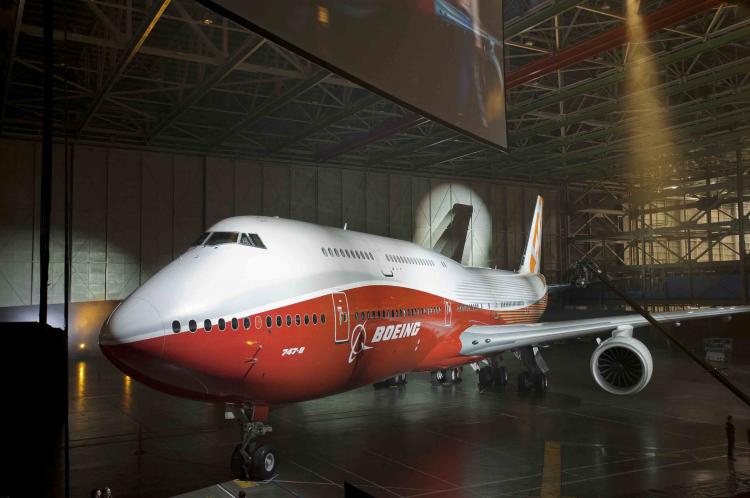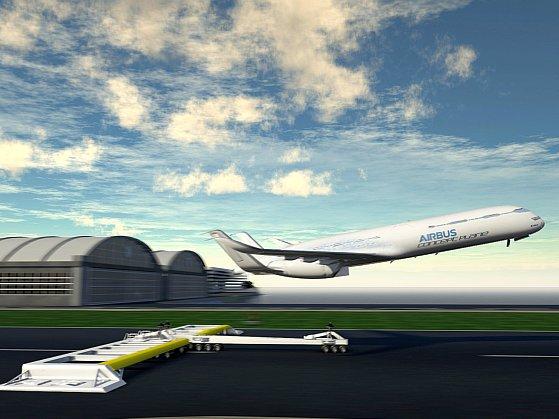The unveiling of Boeing’s newest airplane—the 747-8 Intercontinental—got the attention of quite a crowd recently during its official unveiling ceremony at a company plant in Everett, Wash. During the ceremony, nearly 10,000 people caught a glimpse of the new aircraft that featured a surprising orange color— an unexpected departure from traditional Boeing blue.
At the event, Boeing Commercial Airplanes President and Chief Executive Officer Jim Albaugh announced that the new 747 incorporates a number of technological advancements that would make it attractive to airlines.
A lot is at stake when developing a new aircraft model. When a manufacturer invests in a new design it has to ensure that the product will be profitable, efficient, and environmentally sound.
So what makes the new Boeing 747-8 so special? Boeing emphasizes that the plane will have the lowest cost per seat for a mile traveled compared to any other large airliner. Compared to its predecessor, the 747-400, the new plane will achieve 16 percent improvement in fuel economy, 16 percent less carbon emissions per passenger, and will produce 30 percent less noise.
Boeing says they’ve developed key features that make the latest version of the 747 family stand out in its class.
Story continues after slide show
[etssp 246]
With a maximum cruising speed of Mach 0.86 and a range allowing for a nonstop flight from New York to Hong Kong already put the 747-8 at the top of Boeing’s high performing craft, but this is just the beginning.
At a first glance, the 747-8 looks very much like its predecessor, the 747-400, with signature front double-deck section. But a closer look reveals that the 747-8 is slightly longer by a mere 5220 inches. The extra length allows for enough room to fit 51 additional seats in a three-class configuration, and 26 percent more cargo volume—enough space for two more palates or containers stacked in the cargo haul.
It may be larger, but the new aircraft still has virtually full access to the 200 airports that the 747-400 is now able to operate, unlike the Airbus 380 which forced airports to make modifications in order to house the jumbo liner leading to runway and jet bridges adaptation.
The 747-8 incorporates significant technological advances, including some inherited from the 787 Dreamliner, to meet stringent environmental regulations and respond to current industry trends for fuel economy. The Boeing 787 Dreamliner is a long-range, mid-size, wide-body, twin-engine airplane officially introduced in July 2007.
With a 747-8 wingspan of 224 feet and maximum take off weight of 975,000 pounds the plane can travel as far as 8000 miles in a single trip. The updated wing design is one of the many improvements that allow for such performance. Improved aerodynamics and greater fuel capacity that do not compromise speed allow this craft to achieve results that far surpass its predecessor the 747-400.
The craft’s superior raked wingtips lead to improve fuel efficiency and climb performance by greatly improving wind drag. The shortened take off field length is also significantly improved due to the improved wings—allowing the plane to take off and climb away faster from the congested airspace over airports.
The 747-8 engines might not look any different than the typical model. However, Boeing claims that the 747-8 engines are “one of the leanest, quietest, and most fuel efficient turbofan engines in the world”—an improved and adopted version of the 787 Dreamliner engines.
The core specifications of the engines show that they can produce 67,500 pounds of thrust, have 13 percent lower fuel burn and carbon dioxide emissions, and are easy to maintain.
In response to noise complaints, the 747-8 engines are also designed to be quiet. Noisy planes can disturb residential communities near airports, so some facilities impose restrictions by creating landing and take off windows for aircraft—the London Heathrow Airport in particular has very strict landing and take off restrictions. Yet the 747-8 is so quiet that is allowed to fly in and out of this airport 24 hours a day.
Along with the technical modifications made to the engines itself, there are two distinctive improvements that make the 747-8 so quiet: the nacelle of the engine—a cover housing—is fitted with a sound absorbing inlet liner that reduces noise; and the Chevron (V-shape) on the exhaust nacelle and the engine nacelle reduce noise during take off.
Next: Environment
At the event, Boeing Commercial Airplanes President and Chief Executive Officer Jim Albaugh announced that the new 747 incorporates a number of technological advancements that would make it attractive to airlines.
A lot is at stake when developing a new aircraft model. When a manufacturer invests in a new design it has to ensure that the product will be profitable, efficient, and environmentally sound.
So what makes the new Boeing 747-8 so special? Boeing emphasizes that the plane will have the lowest cost per seat for a mile traveled compared to any other large airliner. Compared to its predecessor, the 747-400, the new plane will achieve 16 percent improvement in fuel economy, 16 percent less carbon emissions per passenger, and will produce 30 percent less noise.
Boeing says they’ve developed key features that make the latest version of the 747 family stand out in its class.
Story continues after slide show
[etssp 246]
Economics and Performance
With a maximum cruising speed of Mach 0.86 and a range allowing for a nonstop flight from New York to Hong Kong already put the 747-8 at the top of Boeing’s high performing craft, but this is just the beginning.
At a first glance, the 747-8 looks very much like its predecessor, the 747-400, with signature front double-deck section. But a closer look reveals that the 747-8 is slightly longer by a mere 5220 inches. The extra length allows for enough room to fit 51 additional seats in a three-class configuration, and 26 percent more cargo volume—enough space for two more palates or containers stacked in the cargo haul.
It may be larger, but the new aircraft still has virtually full access to the 200 airports that the 747-400 is now able to operate, unlike the Airbus 380 which forced airports to make modifications in order to house the jumbo liner leading to runway and jet bridges adaptation.
Technologically Advanced
The 747-8 incorporates significant technological advances, including some inherited from the 787 Dreamliner, to meet stringent environmental regulations and respond to current industry trends for fuel economy. The Boeing 787 Dreamliner is a long-range, mid-size, wide-body, twin-engine airplane officially introduced in July 2007.
With a 747-8 wingspan of 224 feet and maximum take off weight of 975,000 pounds the plane can travel as far as 8000 miles in a single trip. The updated wing design is one of the many improvements that allow for such performance. Improved aerodynamics and greater fuel capacity that do not compromise speed allow this craft to achieve results that far surpass its predecessor the 747-400.
The craft’s superior raked wingtips lead to improve fuel efficiency and climb performance by greatly improving wind drag. The shortened take off field length is also significantly improved due to the improved wings—allowing the plane to take off and climb away faster from the congested airspace over airports.
The 747-8 engines might not look any different than the typical model. However, Boeing claims that the 747-8 engines are “one of the leanest, quietest, and most fuel efficient turbofan engines in the world”—an improved and adopted version of the 787 Dreamliner engines.
The core specifications of the engines show that they can produce 67,500 pounds of thrust, have 13 percent lower fuel burn and carbon dioxide emissions, and are easy to maintain.
In response to noise complaints, the 747-8 engines are also designed to be quiet. Noisy planes can disturb residential communities near airports, so some facilities impose restrictions by creating landing and take off windows for aircraft—the London Heathrow Airport in particular has very strict landing and take off restrictions. Yet the 747-8 is so quiet that is allowed to fly in and out of this airport 24 hours a day.
Along with the technical modifications made to the engines itself, there are two distinctive improvements that make the 747-8 so quiet: the nacelle of the engine—a cover housing—is fitted with a sound absorbing inlet liner that reduces noise; and the Chevron (V-shape) on the exhaust nacelle and the engine nacelle reduce noise during take off.
Next: Environment






